Meredith R. Stoddard's Blog, page 4
April 7, 2020
Office Hours: Quarantine Tales
Once again I talk about productivity in the age of COVID-19
What’s New:
My Stay at Home book sale is still going on. That’s 3 books for 3 bucks, so tell a friend.
Books are now available at ALL major ebook retailers and services like Overdrive and Scribd. Below are links to universal pages that you can use to find the books at your preferred ebook retailer or lender
The River Maiden: Once & Future Book 1
Cauldron: Once & Future Book 2
Thrice to Thine: Once & Future Book 3
I really do recommend ebooks in the age of contagion they offer less risk of transmitting the virus than paperbacks that have to be shipped, and they’re often less expensive and delivered faster.
Productivity:Hopefully I’ve broken through the virus anxiety that has been distracting me. I managed to get in some solid writing
Playlists - This weeks favorite productivity tool is my playlists that act as a mental trigger helping me get into the fiction writing mindset. Here are some of the playlists that I use.
The Dark Side of Chopin - I did not make this list, but I find it very useful especially when I need to focus
What I’m Writing: Still Book 4, I’m so close to the end of this one that it’s all I can even think about writing anything else.Workshop Ideas: (as I say in the video, if these sound good or there is another you might like to see leave a message in the comments foVoice: Why it’s important and how you can find yours
Genre and how it informs how you move forward

The Gaelic Otherworld: John Gregorson Campbell's Superstitions of the Highlands and the Islands of Scotland and Witchcraft and Second Sight in the Highlands and Islands (Scots Gaelic Edition)
By Campbell, John Gregorson
What I’m Reading:
Non-Fiction
March 24, 2020
Office Hours: Why are all these people in my office?
Today, I did the first of what I hope will be a regular live stream to connect with readers. This was on my Facebook page, and in the Kettle Holler Literary Society group, but I’ll share it here so you can watch. Feel free to drop me a line if you have feedback on any of the topics I discuss here or any questions you might have. Notes and links to books mentioned below.
Topics:
What’s new?
Life right now - How the Stoddards are coping with quarantine and how it affects writing
Book Sale - All the Once & Future books are currently only .99 each. That’s 3 book for $3. Please tell a friend or twelve
Going Wide - The Once & Future Series is no long exclusive to Kindle for ebooks. In the next day or so you should be able to find these books on Barnes & Noble, iBooks, Kobo, Overdrive, Scribd and others. I will post an updated link when the books are live on other platforms.
Productivity
Recent events affecting productivity
This week’s goals
Carve out my new writing time in the new routine
Finish the scene I’ve been working on for way too long
My best productivity tool - Pomodoro Technique
What I’m Writing
Book 4 is progressing. I hope to have a draft done by the end of April
What’s next? Plotting Book 5
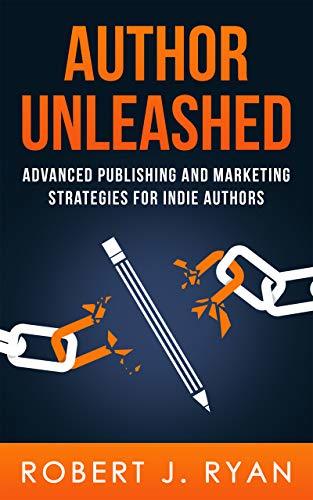
Are you writing and how can I help?
Where are you getting hung up?
Possible workshops
What I’m Reading
Non-fiction: Robert J. Ryan’s Author Unleashed
Fiction: Bella Andre & Jennifer Scully’s Reckless in Love
What I’m Crafting
February 28, 2020
Shed Diaries: Back to work
It’s been over two weeks since I made a shed diary post. That’s mainly because I’ve been working on the shed and then working on Book 4. I did intend to give folks an update, but I was so hot to get back to writing that I was eyeballs deep in the Once & Future world before I was able to formulate a post.
In the last update Speed Bumps, I was waiting for windows and electrical. I’m happy to say that both of those were taken care of in short order.
The next step was cladding the walls. We had originally planned to do paneling, but my wonderful husband saw some blog posts and videos about faux ship lap, and he was bit by the ship lap bug. It was a lot more work, but the result is fantastic.
I learned a few things about faux ship lap.
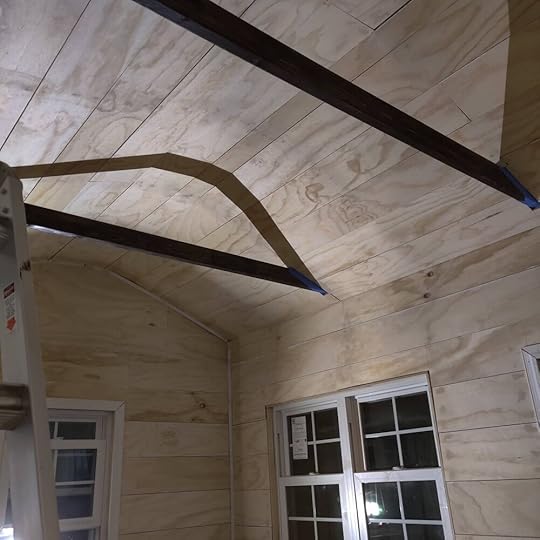
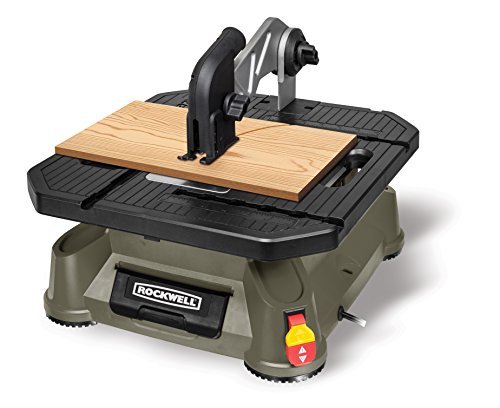
Most of these faux shiplap posts will tell you that you can get plywood ripped into boards at Lowe’s or Home Depot. While this is true, I will caution you that when ask the guys at the cutting station to rip sixteen sheets of plywood into eight-inch boards you will probably get some uneven cuts. A job that big, will often get split up around other smaller jobs, and there isn’t a guarantee that they will set their saw back to the exact same measurement as before.
If you’re going to do this, you MUST have a nail gun. Seriously, this job would have taken a thousand years, or at least felt like it if we’d had to nail each nail each board with a hammer.
Also would recommend having a table saw. Sadly we limped along with a circular saw and a jigsaw for cutting holes for the outlets. We had to rip some boards lengthwise to fit at the bottom of the wall and the ceiling, and that is incredibly hard to do with a circular saw and some sawhorses and clamps.
Also, have a speed square. It makes marking the boards for cutting straight so much easier.
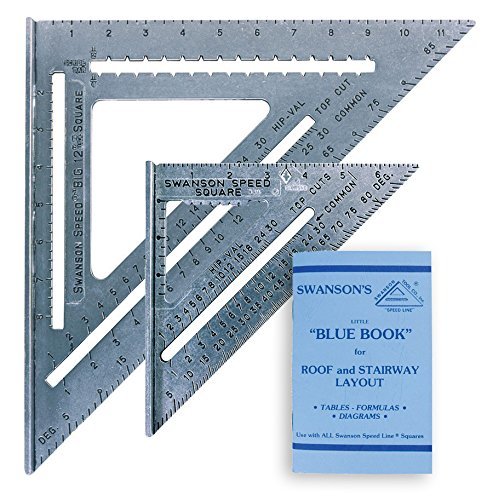
Then we had a paint party. Eric and I were exhausted after putting up the ship lap all day, but we gathered the kids and put on the family playlist. We sang songs and painted the walls and ceiling making bets on whether the single gallon of paint that we bought would do the whole interior (it did). Our kids are thirteen and sixteen now, and it often feels like we’re all going in different directions. But this was one of those magical family moments that I am always going to cherish.
Next we did the trim and the floor. Here we learned that our sixteen-year-old is really good at installing vinyl plank flooring. The kid took to it right away and had our Smartcore vinyl planks installed in just a couple of hours.
That meant I was able to move in my desk and the rest of the furniture. Now, I’m working in my writing shed every day.
We still have some trim on the interior to get done, and a lot of work outside, but I’m excited for what comes next, and for how much time I have spent writing since moving in.
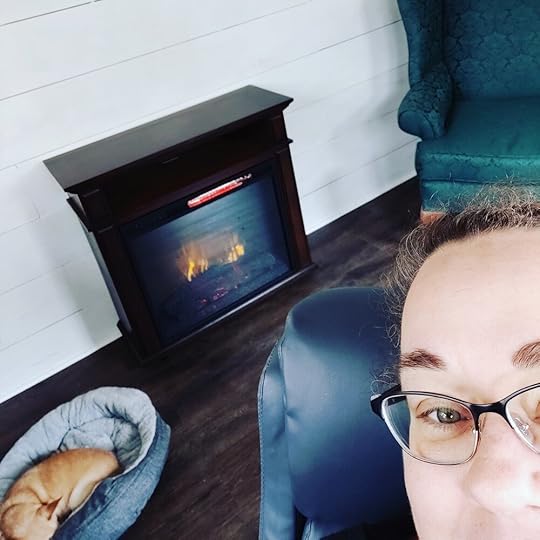
Happy writing in my new space.
February 6, 2020
Shed Diaries: Speed bumps
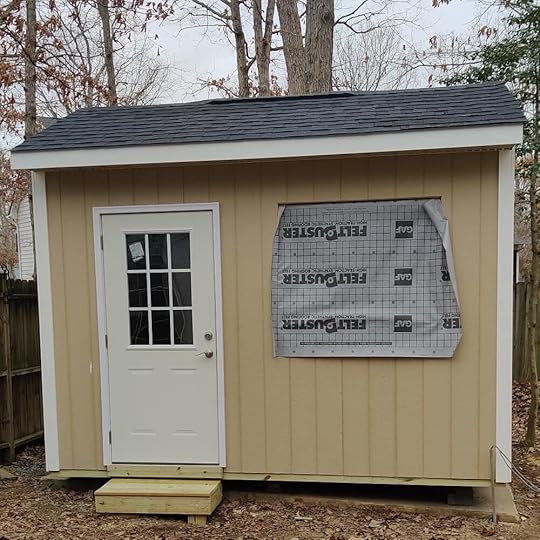
Last week I told you about our plans for my new shed office. Well, I’m excited to say that we have an ALMOST completed new building in our back yard. Now that it’s there, I’m getting crazy excited about being able to walk out the back door with my morning coffee and getting my words in. I’m ready to put my desk in there now. But there are a few things left to do on the inside. And unfortunately the building isn’t quite done.
Speed bump #1: It seems that the builder’s supply company that was supposed to get the windows, let the order for my windows sit on a desk unsent for a couple of days. So I currently have roofing paper covering the windows, and am waiting. They are telling me that it will be done by the weekend.
Speedbump #2": Our house is almost thirty-five years old, and with that comes older wiring. As I learned researching my last book, electrical wiring should last for decades and thirty-something isn’t that old. However, breaker panels have evolved in the last last thirty-odd years and the one that we have doesn’t fit the brand new breaker that Eric bought at Home Depot. Our electrical guy says that we’re going to have to go to an electrical supply store to find out vintage style breaker. So, that’s on my to do list today. Hopefully, we won’t have to order it.
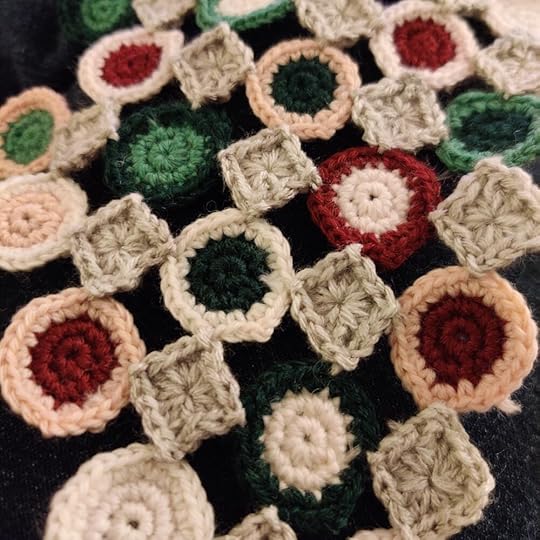
Fortunately, all the wiring in the shed is done, which means that I can go ahead and put in the insulation. That is next on our shed finishing to do list. Sensitive skin and sinuses run in my family, so I’ll be donning mask, gloves and long sleeves to install the insulation that is currently sitting in the garage. After that We’ll be tackling wall covering. But that’s a conversation for another day.
In the meantime, I am also working on some Sophie Digard inspired crocheted valances for the windows. I chose the colors to match a wing-back chair that I bought to go in the office and to evoke flowers which I hope to plant around the shed once it’s done. The yarn is DK weight, but I’m using a smaller needle (2mm) than is recommended for tighter stitches. That is A LOT of stitches. I think my hands would absolutely be cramped up and hurting if I wasn’t using an ergonomic hook.
Back in November, my mom very generously signed me up for a workshop with Arne & Carlos to learn how to make their ridiculously adorable knitted birds. And they recommended Prym Ergonomic knitting needles. Since wee Fergus had chewed my bamboo needles in the size that I needed for the workshop, I bought a set. I LOVE them. The barrels of the needles are sort triangular in shape, and even have minor indentations where you would usually hold them. They really do feel good in your hand are a bit easier to handle than steel or bamboo needles and they don’t tend to slip.
As for crochet needles, I picked up a Yarniss ergonomic hook It has a thicker handle and comfort grip, along with latex, non-slip coating. It is really making a difference. I expect that over time I will be converting all of my needle and hook collection to ergonomics. Yeah, they’re a bit more expensive, but they’re less expensive than carpal tunnel surgery.
I can’t wait to show you the finished valances and the next steps on the shed. Come back next week for an update.
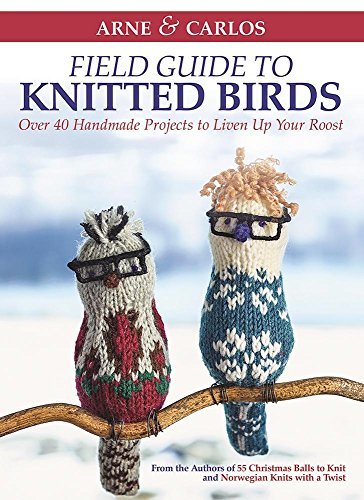
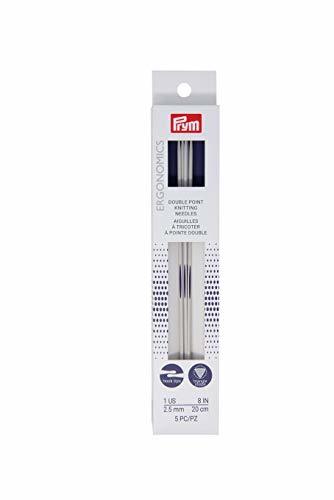
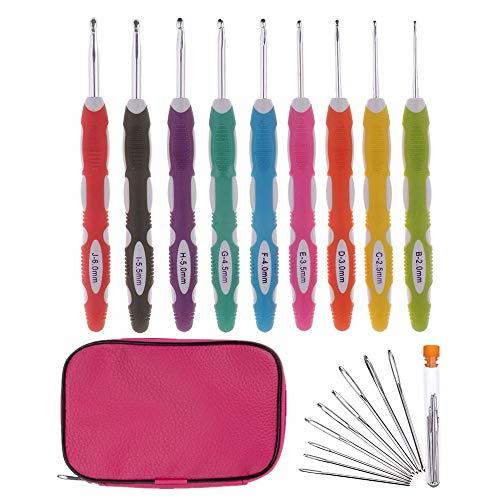
January 28, 2020
Shed Diaries: A Shed is Born
Okay, you’ve all seen the State Farm commercial about the woman who’s she shed catches on fire. For a lot of American’s that’s the first time they heard the term she shed, but I’ve had my eye on a she shed for a while. If you’ve been reading my blog for a while, you might remember my “lady loft” at our old house. It was a big beautiful attic office where I could overlook the rooftops of our old neighborhood, and daydream. It was my retreat space where I did all my business-y author stuff. It’s why my blog is called “Notes from the Loft”.
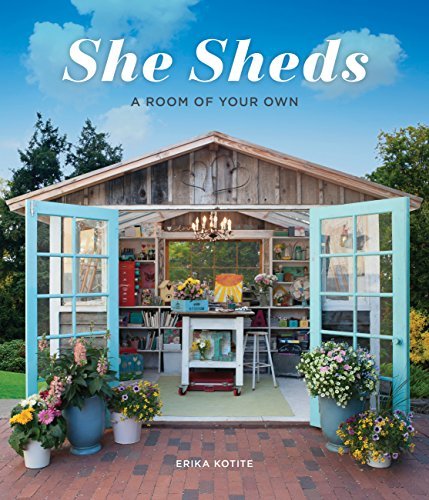
Sadly, my space in the new house is not as inspiring as my space in the old house. It’s a low-ceiling-ed room above our garage with tons of storage space in the eaves. It has only one small window, and that’s taken up by an air conditioner because the room doesn’t have any duct work in it. It’s freezing in the winter, and has no view. It’s less like a loft and more like a cave, and not in a good way.
Now, when I say “new house” I mean the house that we bought two years ago. For two years I have been trying to make this space work, or trying to find another space in the house where I can write. It’s a great room for crafts and storage. It’s a tolerable room for the business-y author stuff, but I can’t write in it. I avoid it. I’ll go weeks without going in there. My other options are the basement (still windowless) or the dining room table (great windows but a lot of traffic when people are home).
So, I write in cafes; Starbucks, Panera, Wegman’s or new local favorite Canal Quarter Coffee by Agora. But café writing has its own pitfalls. Sometimes it’s hard to find a table, or parking. Sometimes I find a good table only for it to be next to a group of people talking loudly, people who think that it’s totally fine to take a conference call where they yell into their phone in a public café, Captain Joystick who plays PC games on his laptop cheering or groaning loudly as he plays (Not kidding this guy is a regular at my local Starbucks). One time I was even sitting behind a man who was working on a book about John D. Rockefeller. I know this because he was narrating it at full volume like newsreel announcer as he typed.
Here’s the thing about daydreaming for a living. You have to find a balance between enough distraction to fire your imagination, and too much distraction to stay in your imaginary world long enough to make the words happen. I considered finding an office share near me. Unfortunately, the locally run one closed down, and the chain one in town only offered a tiny cubicle in a windowless room. I mentioned the office share option to my husband, and he said, “If you’re going to spend money on that, why not spend the money on a shed office that will add a little value to the house?” Sometimes, my guy is pretty smart.
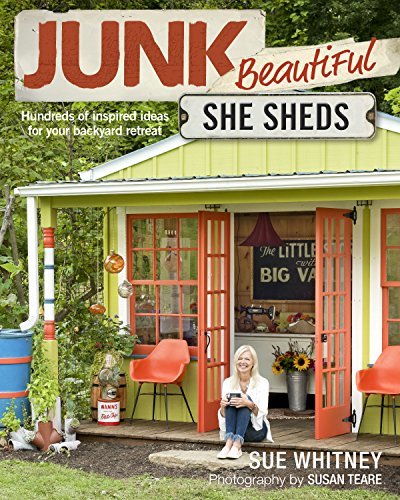
I’ll confess, I’ve been dreaming of my own shed, for years. I would drive by those lots full of pretty prefab sheds and just imagine what I would do. I even have Pinterest board of Writing Huts that’s been around since before the Lady Loft. So, this is kind of a dream come true.
We decided that I needed a she shed, shed office, word hut whatever you want to call it. Many famous writers have had them. Dylan Thomas, Roald Dahl and Virginia Woolf among others all had sheds or garden houses of one type or another to write in. So what do I need to maximize my creativity in my ideal writing space?
Windows – I love natural light, and I need windows to look out. It doesn’t have to be a view of a river or the ocean, but trees would be nice, maybe a garden. But windows are a must.
Electricity – Candles or oil lanterns would certainly be atmospheric, but you can’t power a laptop with lamp oil. If I want to spend a whole writing day out there, I’m going to need a place to plug in.
Removing distractions – Currently, my craft space and my office are the same. The trouble with this is that my imagination has a tendency to want to make things instead of making words. So I need the new shed to be exclusively for writing and author business. Preferably with a way to hide the business stuff while I’m writing.
Climate Control – Because I live in the Virginia with a full range of hot summers and cold winters, and because I’ll be storing books in there in addition to spending a lot of time in there, I’ll need to be comfortable. That means insulation and walls and heating and cooling.
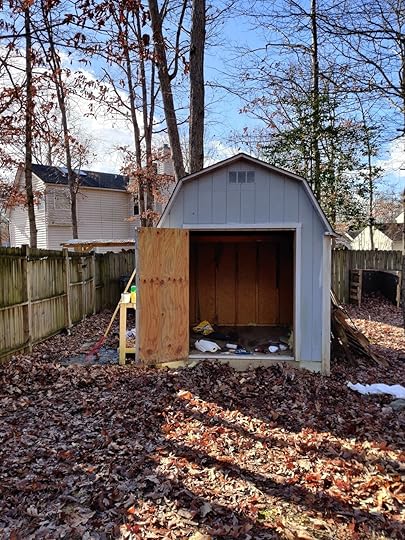
Note trees and fence close to our existing shed. Hard to get a prefab shed in here.
Now, my man is handy. He even built us a deck last year. But he also works long hours and has a long commute, so we knew that he wasn’t prepared to build a shed for me. We looked around at several prefab shed options. We found a couple that were sort like The offered some windows, if not all the windows I wanted, and the price of the prefab models are very reasonable. Plus, there is the added benefit of speed. Prefab models are delivered by truck and put into place. Then the finishing can begin.
The roadblock we ran into on this is that there is not easy way for them to deliver a shed to where we want to put it in our back yard. We already have a slab currently occupied by a small, moldy old shed. Eric and I went home to measure the gates in our privacy fence, and the spaces between the trees in our wooded back yard to see if delivery was even an option. We concluded that the only way we could have a shed delivered was to take down and rebuild part of our fence, something we would rather not do if we don’t have to.
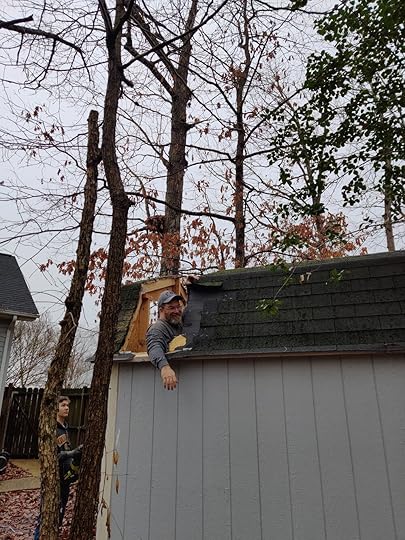
Handy man, Eric tearing down the old shed.
Then we found Affordable Sheds. This is a locally owned business that will build a custom shed on your site for just a fraction more than a prefab. Once we sat down for a few minutes with the owner, I was sold. We ordered my new shed office. It’s a 12 x 10 ranch style shed. It will have just the right number of windows, including lights in the door, 8 foot walls, and a big shelf for storing my paperback stock and book festival tent and supplies.
Now, it’s just a matter of getting it built. We tore down the old shed this past weekend, and Affordable Sheds is scheduled to build my new office on Monday 2/3. The electrician is scheduled for the following weekend. Fingers crossed the weather holds out.
Check back here and follow my social links for updates on building, finishing and furnishing the shed.
December 19, 2019
It's beginning to look a lot like...
…Book 4
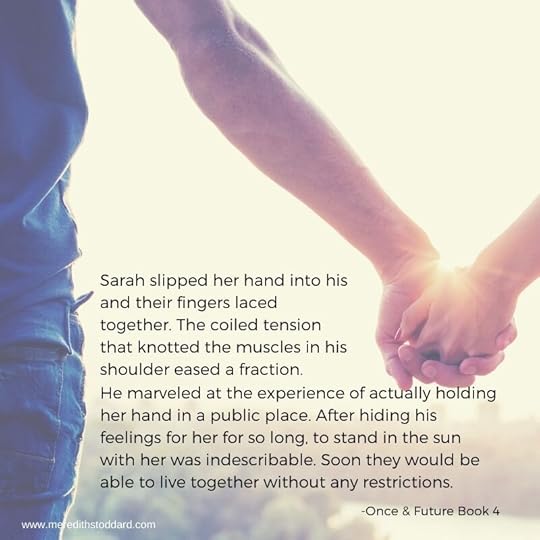
That’s right folks. Book 4 is coming along nicely. I set a goal back in January to draft two books this year. I needed a palette cleanser after the first trilogy, so I wrote some women’s fiction. It doesn’t have a title yet and won’t be out until after Book 4, but I think you all are going to like it. It’s in revision now, but it took a bit longer to write than I planned. So I didn’t get started on Book 4 until about mid-October. The bad news is that the first draft won’t be finished by the end of the year. The good news is that I’m almost to the mid-point. While I won’t be reaching my goal of drafting two books in a year, this is still MUCH FASTER than any of the previous books have been. I might be learning how to do this novel writing thing after all.
With that said, I am SO EXCITED for Book 4. And because I’m so excited for Book 4, I’ve got a couple of tidbits to share. First, the working title for Boo 4 is officially Nothing Good Gets Away. Working titles are always subject to change, but I’m getting pretty attached to this one. It comes from a letter that John Steinbeck wrote to his son on the occasion of his first love. It’s a beautiful letter, and a beautiful sentiment, but taken out of context those words become very equivocal. I dig that in a title.
The other thing I will share is this brief scene from Nothing Good Gets Away, because I know you’re just dying for a peek.
Edinburgh, Scotland
April 1996
They stepped off the bus on Princes Street near North Bridge. Dermot slung his bag over his shoulder. He surveyed the street hoping that the heavy foot traffic meant they could blend in. Sarah slipped her hand into his and their fingers laced together. The coiled tension that knotted the muscles in his shoulder eased a fraction. He marveled at the experience of actually holding her hand in a public place. After hiding his feelings for her for so long, to stand in the sun with her was indescribable. Soon they would be able to live together without any restrictions. As soon as they met up with Des, Sarah MacAlpin and Dermot Sinclair would disappear. They would start again with new identities.
He lifted their joined hands and kissed the back of hers. She rested her cheek on his arm. He turned to find her eyes on him, green and brimming with love. Her hair was once again tucked up under a brown knit hat to hide her distinctive curls. He flashed back to the wee hours of the morning when she’d awakened him and they’d made love again, her hair brushing his chest soft and ephemeral. She squeezed his hand with reassurance. One more thing to do before leaving Edinburgh, and they’d be free.
Someone on the street bumped his other shoulder reminding him that they needed to be moving. They paced themselves with the other pedestrians up North Bridge to the High Street before turning down Cockburn. The cafe where they were to meet Des was a few doors past Fleshmarket Close. He walked Sarah to a tourist shop across the street. He didn’t want to leave her there, but after Des’s warning the day before, he wasn’t entirely sure he could trust his old friend. She could watch from a safe distance here and her American accent wouldn’t be noticeable among the other tourists.
They spent a few moments browsing the souvenirs until the shop keeper, a young man who seemed largely indifferent to the half dozen shopping tourists. After a few minutes he picked a snow globe from a shelf and stepped closer to Sarah, who was combing through a rack of tartan ties. “Amy would love this.” He said loud enough for the middle aged woman a few feet away to hear.
Sarah leaned in as if to look at the snow globe. “You’re right. She would.”
In a low voice he said, “I’m going. If anything, anything happens across the street, or if I’m not back in ten minutes…”
“Don’t say it.” She hissed.
“…You take yer papers and go. Start a life somewhere.”
“I’m not leaving you.” She said.
“I think that saltire tie would be great for yer da.” He said sensing another browsing tourist had strolled within earshot.
Sarah looked over her shoulder at the older man who was a few feet away looking at golf club covers. She turned back to him and lowered her voice. “I wouldn’t blame you if you changed your mind. But if that’s what this is just tell me now.”
He smoothed a hand down her arm and caught her eyes with his. “My mum told me to take care of you. That’s what I mean to do. Nothing else matters.”
“You’re giving up so much.”
“I’d sacrifice everything for you.” He whispered. “Dinna be here in ten minutes, whether I come back or not.”
She handed him the snow globe, before pressing herself against his with a devilish look in her eyes. “Have I mentioned how much I liked waking up next to you this morning?”
“I mean it. Stay safe no matter what.” He planted a kiss at her temple and deposited the snow globe on the shelf beside them. He left to make his way across the street.
***
Sarah left the rack of ties and positioned herself by a rack of t-shirts where she could watch the cafe through the shop window. She saw Dermot walk across the street and enter the cafe. Naturally, the mysterious Des had not picked a table near a window for their meeting. Dermot disappeared behind the glare of the sun on the cafe windows. She forced herself to look at the shirts to keep up their pretense of souvenir shopping. She rolled her eyes at one that said “Kilt Inspector”, and flipped past one with the Stuart Lion Rampant. She couldn’t help feeling as if they were being stalked by a lion. There she was hiding in the tall grass hoping that she and Dermot could get to a safe place before the Stuarts could devour them.
Out of the corner of her eye she noticed a motion from across the street. She glanced over there, trying not to be too obvious. A couple of women were coming out the door of the cafe laughing at something, and away down the street continuing their conversation. Sarah checked outside the cafe to see if there was anyone loitering, but all she saw was a typical day on a street in the Old Town. Tourists strolled by pointing at the architecture of the old stone buildings or pulling their suitcases down the steep, curving street to Waverly Station. Locals bustled by on their way to work. Nothing out of the ordinary. No stalking lions. She checked her watch. Dermot had been gone for five minutes.
Sarah went back to the rack of shirts and continued pretending to shop. Another shopper began flipping through the shirts on the opposite wide of the rack, and Sarah’s pulse leapt. She hoped that tourists would be too interested in their own travels to pay attention to the local news or U. K. tabloids. It was why she had stayed in the hotel yesterday while Dermot had run about town getting cash and if all went right across the street a new identity. It had been weeks since the tabloids had first published her picture and connected it to billionaire playboy, James Stuart. Weeks of cramming her hair into a knit cap and wearing fake glasses. Weeks of living in fear of someone recognizing her. Now that she and Dermot had disappeared after their car accident in the Highlands, James himself was flashing her picture all over the television. If they stayed in Scotland much longer the hat and glasses were not going to be enough of a disguise. Sarah glanced up at the woman who gave her a cordial smile and moved on to the next rack that held rugby shirts.
She felt a second of relief before she checked her watch. Seven minutes. Dermot better come back soon, or she might have to go into the cafe to get him. She had no intention of leaving without him, even if that was what he’d told her. With all that he was willing to give up for her, she would rather brave the lion than be without him. She picked a shirt with some clan badge on it and held it up in front of the window. Looking past the shirt she eyed the cafe. Outside she tried her best to look calm, but inside she was a ball of nerves.
Now that you’re properly teased and probably mad at me for taking too long to write it. I have not one methadone list for you but three. As you know I love to research. So, I have three lists of further reading.
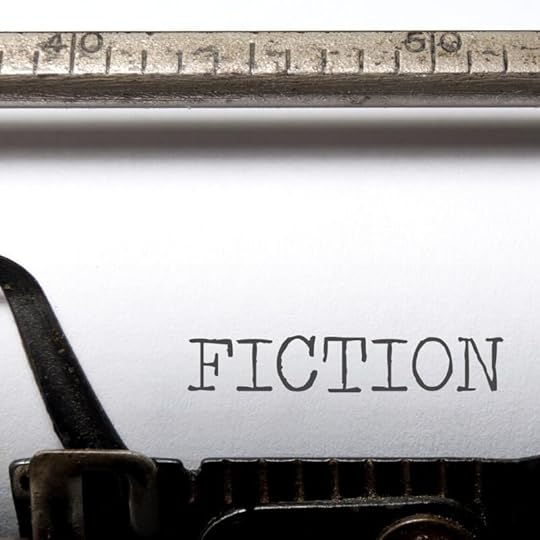
These are works of fiction recommended by me and fellow Once & Future readers to entertain you while I’m working on the next installment.

These are some books that I recommend looking into if you would like to learn more about the folklore of Scotland and Appalachia.

These are some books on history, and maybe a few on conspiracies that helped inspire and inform the Once & Future Series
October 11, 2019
Putting some flesh on those bones
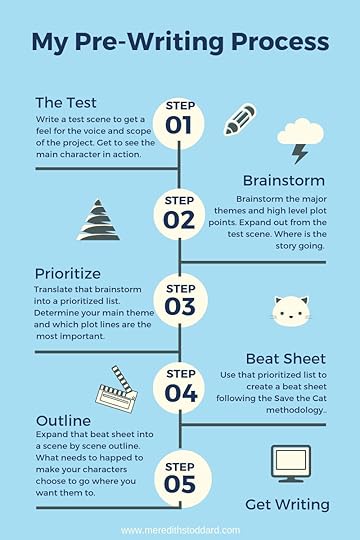
Are you still with me? Got your Beat Sheet ready? Now that you’ve sketched out the main arc of the story, It’s time to dive in and make a scene by scene outline. This is where that prioritized list and Beat Sheet get translated into your story. Think of the Beat Sheet as high level telling what will happen in your book. Now, it’s time to get to showing.
Some of those story beats make it easy. Your opening image is one scene. As the saying goes, “You never get a second chance to make a first impression.” And that opening scene is your first impression. So, you want to make it a good one. The Catalyst is another one that can usually be covered in one scene. Other story beats allow for more scenes. Setup, Debate, Fun and Games…these can and should take multiple scenes. In chapter two of Save the Cat Writes a Novel there is a break down of the Beat Sheet that includes which percentage of you story should be covered by each beat.
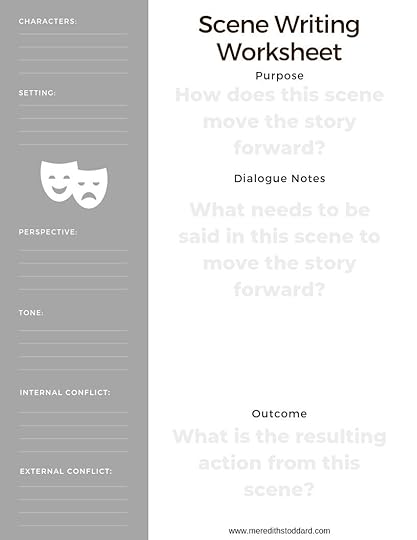
If you want more room than an index card offers to work out your scene, here is a worksheet to help. Click here for .pdf
In putting together your Beat Sheet, you hopefully already started thinking about scenes for each of these beats that will move the story along. This is where those story physics that I mentioned before come into play. What needs to happen in each scene in order to propel your characters to the next? What should happen to make your main character choose to move from Point A to Point B? Are those events believable? Are those choices in character for them? Some things you should be thinking of as you put these scenes together.
Because these scenes sometimes move around in order, I like to use cards, or Post-It Notes to lay them out. I color code these cards according to the main plot line that is addressed in that scene. That doesn’t mean that a scene can only move one of those plot lines forward. It’s great when a scene can move multiple lines forward, but there will usually be one more than others so I go with the primary one. I pull up my beat sheet on my screen and walk through it writing a card for each scene that I think is needed to accomplish each beat. I know that I could just type the cards into Scrivener, and I will eventually, but as with brainstorming, I like to be on my feet for this part.
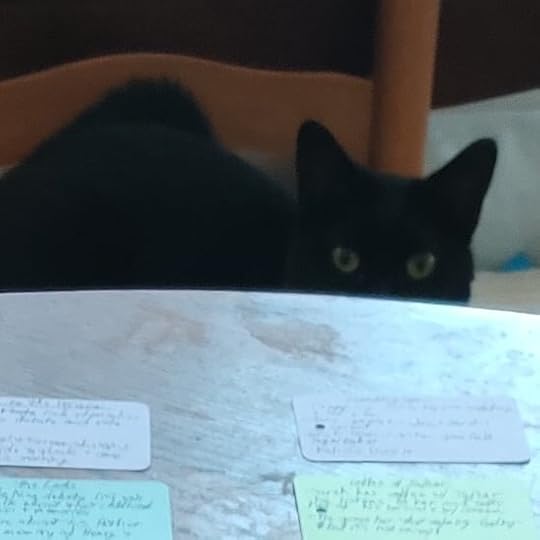
Sometimes I have helpers when plotting.
According to the Save the Cat structure, we are looking for three acts (although Act 2 is divided). I lay the cards out in columns for each act; Act 1, Act 2A, Act 2B. Act 3. Once again getting that bird’s eye view of my outline. This is the time to look for plot holes, or gaps in the plot lines. Now I can add scenes or notes to cards where needed and rearrange cards if I want to. I usually do a few passes at this, layering in the different plot lines with each pass.
This is where that color coding comes in handy. If you see a section where there is a color missing, you might want to add a scene for that plot line. If you read Save the Cat, this is where you want to make sure your B story is appearing in each act. If you’re writing a series like me, you want to make sure that the plot for this book is moving forward, but also that the larger series arc is moving forward too. It may move at a slower pace, but it should be included periodically to remind readers of the larger plot.
Once the cards are laid out, you’ll want to store them in order. If you’re using the cards that I linked above, They come with rings that can be used to bind them together. You can also use a box, or like in this video, a card binder. I like the binder because I can take it with me when I work outside the house, and I can flip through it to get that bird’s eye view easily.
I found this video particularly helpful. Author, Shaunta Grimes shows off her portable plot book. Links are included in the description for the binder she’s using.
Once I have my cards in order, I put that outline into Scrivener. I don’t necessarily divide it into chapters yet. That can wait until I’m done writing. However I do create a folder in my outline for each Act and each of the beats in that act. Then I use the Corkboard view to recreate my index cards in the computer, and use the labels to match the color coding on my cards. I realize that this might seem like double work, but every time I retype the scenes and beats of my outline, the story is evolving. I’m layering in details and building ideas for my scenes and getting into the mindset of the characters. All of this is building the right frame of mind for me to get writing.
I hope these posts have helped some of you think more about the pre-writing process. If you have trouble getting started or start, but have trouble finishing, I hope that some of these techniques can help you keep your project moving.
October 4, 2019
I'm Plotting Something

If you’ve come here from the Getting Started post, then I’m super excited that you’re still reading. Only serious writers like to get this in the weeds about process, so congratulations. You’ve earned your Serious Writer Merit Badge. What qualifies me to give you this merit badge? Absolutely nothing except that I am super nerdy about the writing process and I like it when I meet my people. If you’re still reading after the last nerdy post, then you’re my people.
To recap, this series of posts is about my pre-writing process. The previous post was about the first three steps in my pre-writing routine. In this post we’re going to focus on Step 4, the Beat Sheet.
I’m not going to teach you how to do a beat sheet. That has already been covered by more experienced and successful writers than me. I will however refer you to where you can learn to do it from them, and talk about why I love this way of looking at your novel and how to structure it.

After I finished drafting the Haverhill project, I decided to get into a plotting frame of mind by reading a book that’s been on my TBR shelf for a while, Save the Cat Writes a Novel. If you’re not familiar with the Save the Cat plot structure, I highly recommend checking it out. It started as a guide for screenwriters to help them develop successful screenplays. The method focuses mainly around something called a Beat Sheet. The idea is that to keep your story moving and following an arc that will keep readers turning pages, you should focus on a set series of story beats.
Now, you might be saying, “But Meredith, that sounds awfully formulaic.” I hear you, but this isn’t about WHAT those key plot points are so much WHEN they should fall in your story. There is an expected rhythm and crescendo to story telling that hooks audiences and keeps them reading through the end. Some writers do this instinctively., some just spew out their draft and then mold the story into a compelling arc during the revision process. I prefer to at least map it out before I start writing. This gives a framework for us to articulate that story.

Yes, it’s a bit vague toward the bottom because spoilers.
It’s sort of like therapy. You go in with a jumble of emotions, and your therapist (hopefully) asks the right questions to help you make sense of that jumble and move forward. The great thing about Save the Cat is that as a structure it gives us a framework that melds the writer’s story idea with the audience/reader experience. How do we as writers get our readers to go on the emotional journey that we want our characters to go on? This is where some writer's can slip up. We sometimes become so focused on our idea, or a particular character that we love that we forget that we need to bring the readers along with us on the journey. Save the Cat finds that happy medium between exploring the story in your head and finding a way to make it relevant and entertaining for readers.
I found these questions and framework so inspiring, that I didn’t just outline book 4, but I went back and wrote beat sheets for Books 1-3, and even created a multi-level beat sheet for the whole series, and the rest of the books. There is a helpful chapter in the book about writing Beat Sheets for series writers too. I won’t show you that spreadsheet, because spoilers, But the structure looks something like this infographic.
I’ve been telling reader/friends for a while that I would like to write nine books in the series, which if you’ve read Cauldron or Thrice to Thine should make sense. But until this I only had vague sketches about how the five books to come after Book 4 would play out. I knew where the series was going and who some of the chief characters would be, but I wasn’t sure how I was going to get it there. Creating these Beat Sheets had really helped me to map out where the next books are going. I’m super excited and energized.
Next time I’ll talk about turning that beat sheet into a scene by scene outline.
September 25, 2019
Getting Started
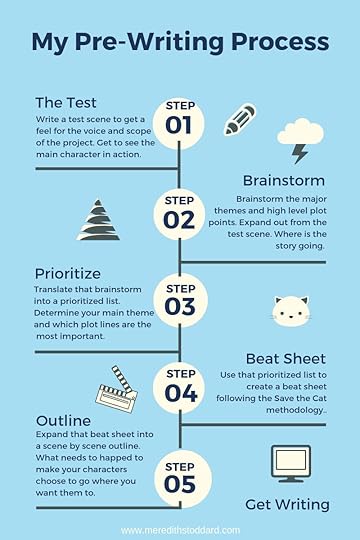
I talk to so many people who say that writing a book (novel, memoir, non-fiction) is a goal or theirs but they don’t necessarily know where to start, or if their story is interesting enough. So, I thought I would share how I get started on a project.
I’m a plotter. Always have been. I could use the MS Word outline formatting in my sleep. I even outline blog posts. I do scene by scene outlines of my novels, because with all the distractions of motherhood, and the internet I need a road map to be able to jump back into my fictional world. I’m not a slave to my outline. I take detours. Just like the GPS on your phone, I can reroute as needed. But I still need that map,.
So, when folks tell me they want to write but; they don’t know how to get started, or they have an idea but can’t seem to get it from their brains to paper, or they started but faded or lost the plot. I frequently recommend that they try brainstorming and outlining. It’s hard to lose your way with a road map.
Fortunately, I have some experience helping people draw out what’s in their minds. For years as an instructional designer, I had to ask the right questions to find out what skills managers needed their teams to have and what business processes they needed to learn. Over time, I developed a set of questions that I asked each manager who requested training. What does success look like? What behaviors do we want from your team members? Where do you see room for improvement? I got pretty good at helping people suss out what was in their heads and figuring out how to make it into training. That’s very much what happens when you set about pulling a book idea out of your head and organizing it into that road map that I mentioned.
I thought I would give you all a peek at my pre-writing process. I encourage every writer or would-be writer to explore lots of processes to find what works best for them. This is what works for me.
In this post, I’ll tackle the first three steps of this process. The test scene, brainstorming, and prioritizing. These are the steps that are the jump start for getting what starts as the germ of an idea in your brain, out onto some other medium so that you can start playing around with it to see if it will make a book.
The Test Scene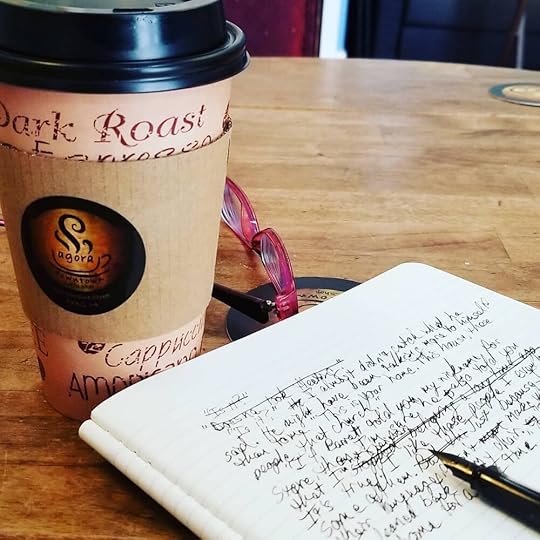
Note the Lamy Fountain Pen. The best pen I’ve ever owned and I’m super picky about pens.
Every project idea starts with a scene. It comes into my head and there is usually something about the character’s voice or situation that I find compelling to the point that I sometimes can’t get it out of my head. So, I write it down, usually long hand. I find that writing longhand is more immersive when I’m trying to find the right voice and tone. Typing on the computer is fine for working on the main project, but first I like to find the voice with pen and paper. This scene is like a test for where the project might go. After writing that scene, I can usually tell if there is enough there for a novel, or if it’s a short story or if it’s not just going anywhere.

I do have felted journal covers in my etsy store, but this one is only mine.
I will often buy a new journal for this purpose. For the last year or so, I have been favoring Extra Larger Moleskine Cahiers. I use an extra large Traveler’s notebook style cover that I made myself so that I can carry multiple notebooks easily. This will become my notebook for the project. After that initial scene, I use the journal for jotting down research notes, character sketches, scraps of dialog that pop into my head…anything related to the project. I am currently trying out a new journal that is designed specifically for this purpose, and I’ll let you know how it works out.
BrainstormingIf I feel like that test scene is going to lead to more, I start brainstorming about the plot and theme of the book. What am I trying to say? Who are these characters? What is this character’s journey? What needs to happen to make this character choose to go where I want them to go? There are so many questions to be answered, and things very rarely come out in an organized way. There are a number of methods for brainstorming. Here is a great explanation of it as well as a breakdown of techniques from the Writing Center at UNC. The best tool I have found for working on a novel is the snowflake diagram. I like the snowflake because it helps me brainstorm multiple plot lines at once and works on multiple levels to help me prioritize items.

small corner of the snowflake diagram for the Haverhill project
Now, in our old house, I had a chalkboard wall that I used for this purpose. I made the wall with two inexpensive chalkboard wall decals that I got on Amazon. There are also white board decals, if you prefer that. If you have a wall that you can devote to this purpose, I highly recommend it. Maybe it’s because I was a trainer, or I wanted to be a teacher when I was little, but there’s something so satisfying about writing the diagram out on a board and being able to step back and review it. That diagram is like getting a birds eye view of the what’s spilling out of your brain. It can show you where your ideas are more complete, and where they might need more fleshing out.
Sadly, my office in the new house doesn’t have a wall that I can use for this. It’s above the garage and has a lower ceiling that slopes. I tried using the whiteboard decals on the ceiling, but all i got was a sore neck. So I have had to content myself with whiteboards propped on a chair. It’s not ideal, but it’ll work for now. I know that there are software programs for brainstorming. I used some when I was creating training material in my previous career. But I seem to focus more when I’m on my feet.
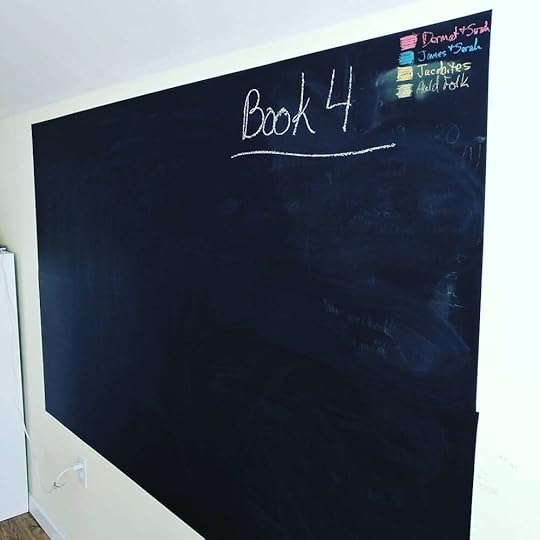
I miss my wall
Prioritize
Of course this diagram is just a step in the pre-writing process. I still need to translate this diagram to a story outline. I start by making a prioritized list of the points on my snowflake. This is not a plot outline. This is a list of the basic themes and high level plot points. If you are using the snowflake diagram or another layered brainstorming technique, you should be partially prioritized already. This step gives you an opportunity to narrow down the main theme of the project as well as the sorting out what might be the main plot versus subplots.
It also gives you a chance to start thinking about the order in which the plot points you just brainstormed might need to happen. Not so much how to get your main character from Point A to Point B, but what needs to happen to make your character move themselves from A to B. What motivates your character through the story and how do those story physics work?
This prioritized list will inform the next steps in the process starting with the Beat Sheet, which I will talk about in my next post.
Readers, for a bit of trivia: What do you think was the test scene that I wrote for The River Maiden?
Dermot & Sarah's first kiss
The Bathtub tragedy
Sarah's vision in the woods
Isobel MacKenzie's song
If you said The Bathtub tragedy, then you’re right. That was the first scene I wrote. I originally intended it as a prologue, but eventually moved it to the flashback that Sarah relates to Dermot, and rewrote the scene from Molly and Granny Maggie’s perspectives for the short story prequel Unfit.
September 3, 2019
On to the next
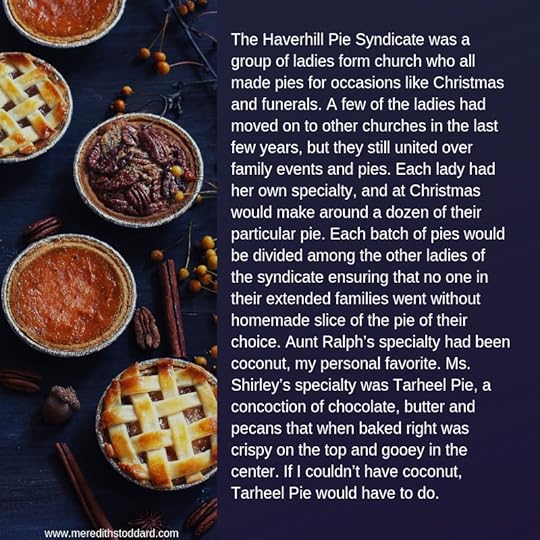
Hallelujah! I finally finished the first draft of my Southern women’s fiction novel. The current working title is Haverhill Harmony, but that is likely to change. Since I usually pick the title after the book is done, I can’t say what the final title would be but I have some ideas.
Seven years after the end of Cauldron, Amy has picked up the pieces of her life. She’s put together an impressive resume as a marketing consultant and moved far away to San Diego, but she’s not really as satisfied with her success as she thought she would be. When she inherit’s her great aunt Ralph’s crumbling Victorian house in her hometown of Haverhill, North Carolina, Amy decides to head home and supervise the renovation and sale of the house. She thinks it will be all business and then she’ll go back to her career in San Diego. Things don’t turn out the way she plans when she’s asked to help revive her family’s dying community church, and her best friend, Barrett, turns up on her doorstep looking for a revival of his own. To add to her complications, she can’t seem to resist her attraction to her contractor, Fleming Sinclair, the last person she would have expected to find in Haverhill.

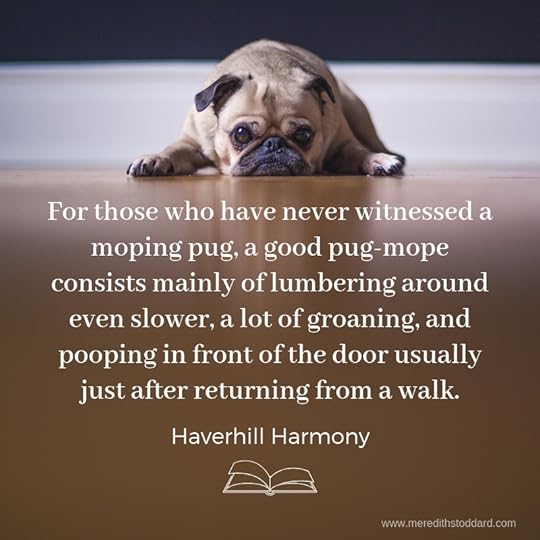
This book promises to be a lot of fun. There are familiar characters in Amy. her old pal Barrett. and Fleming Sinclair, plus some new characters in the form of a handsome young minister, a cantankerous old gossip and a geriatric pug named Steve McQueen.
As always it needs revision, and it won’t be released before the next Once & Future book. Haverhill picks up seven years after the end of Cauldron, so there might be a Once & Future spoiler or two for keen eyed series readers. Although this book follows Amy Monroe, it is not a fantasy book. Instead it is Southern women’s fiction, and hopefully funnier than the Once & Future books. Amy is a particularly sassy character and her internal voice is so much fun to write.
Now that I have drafted this novel, I can get back to Sarah and Dermot. That’s a good thing, because they’ve been whispering in my ear for the last month. I’ve been plotting Book 4 off and on all this time and have most of it outlined. There is a bit more plotting to do, but I should start writing soon. I’m looking forward to getting back to these characters.



